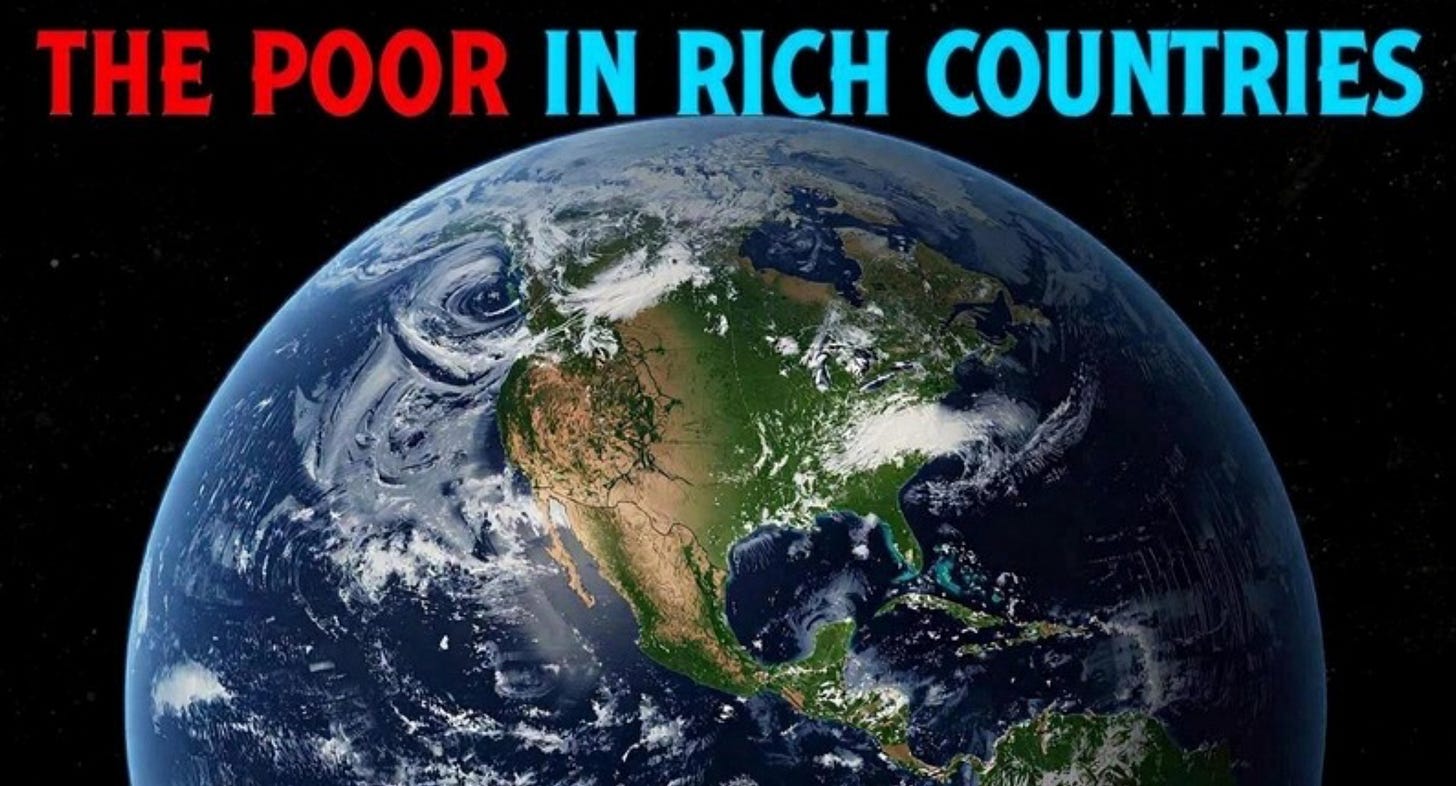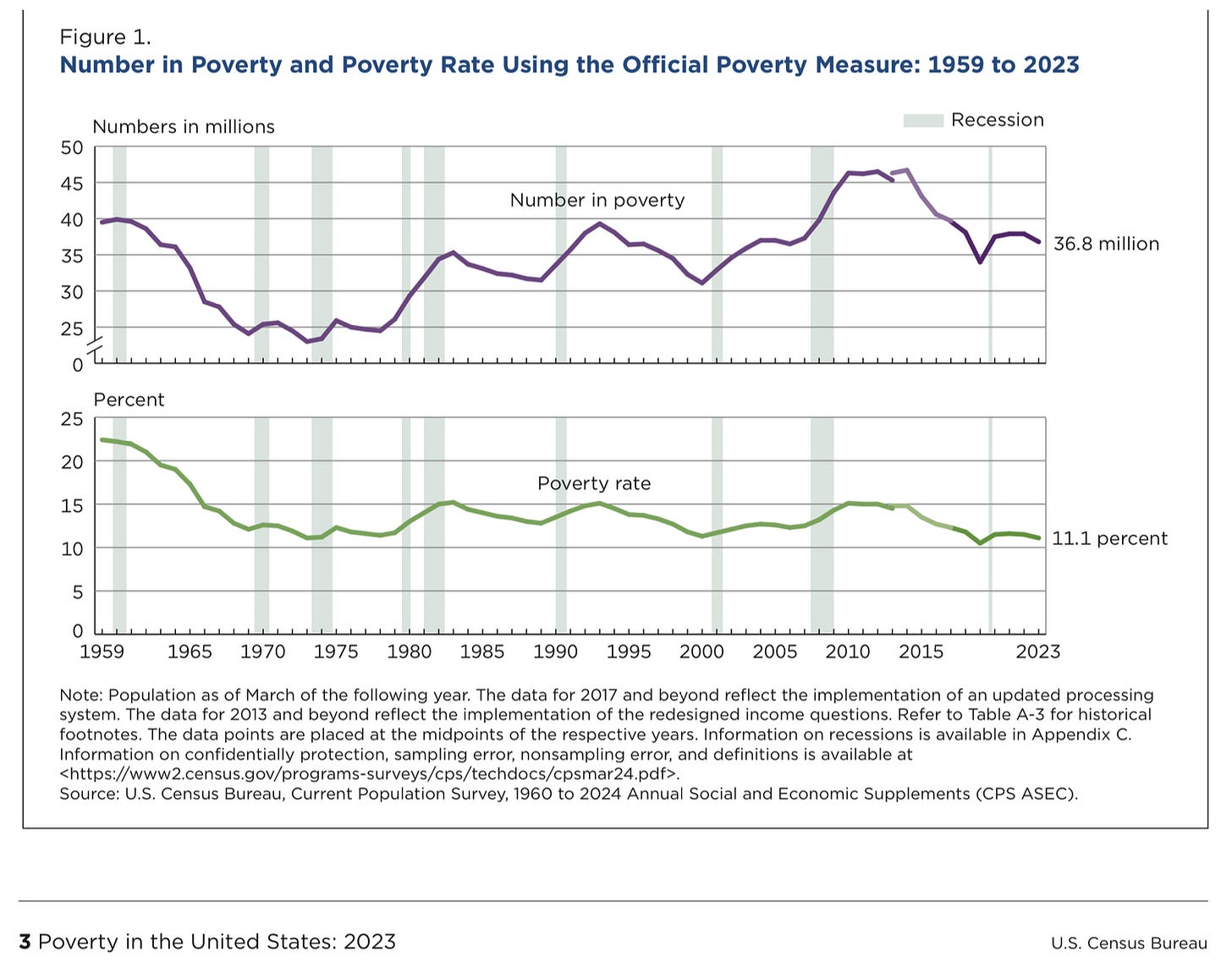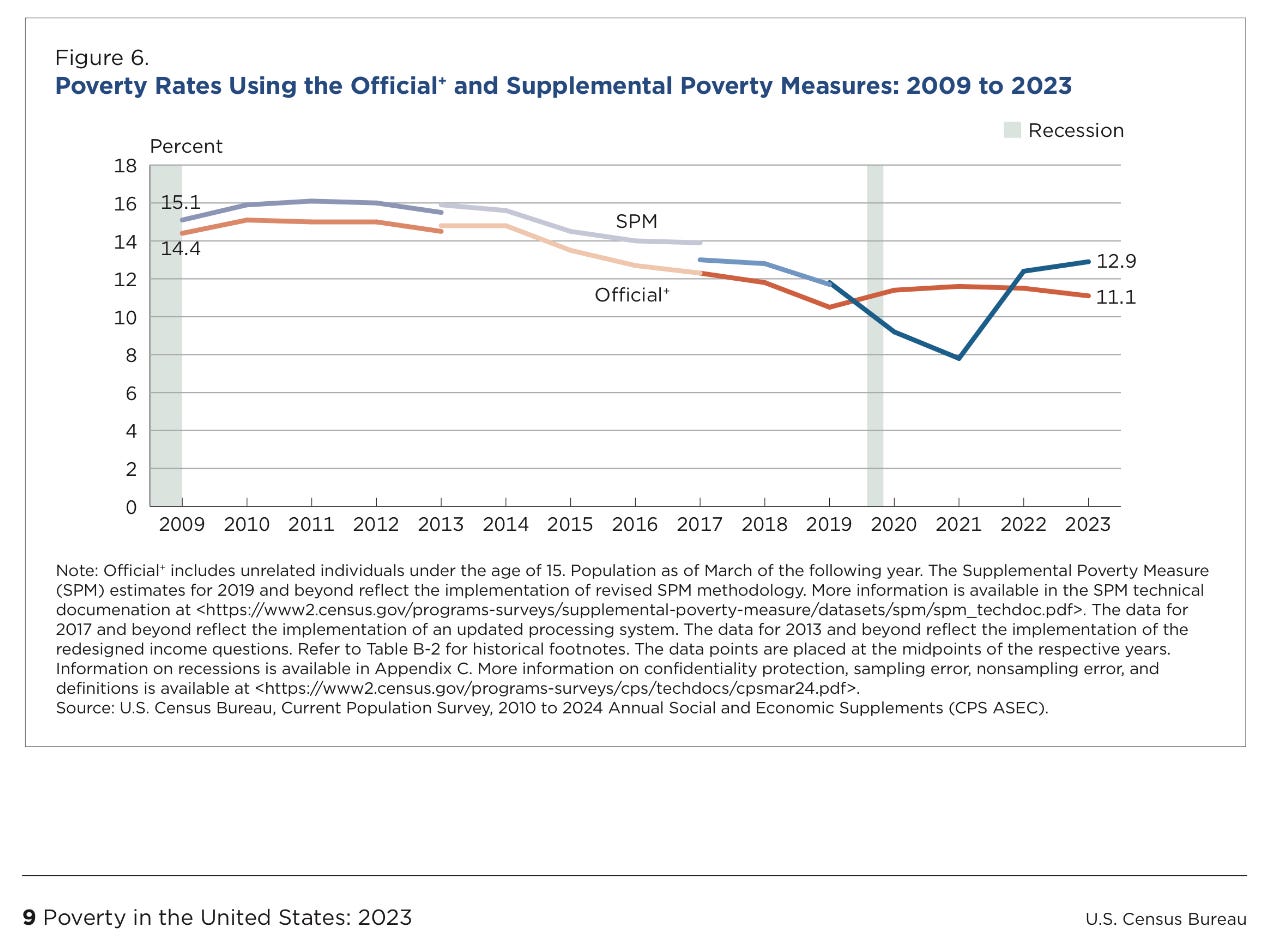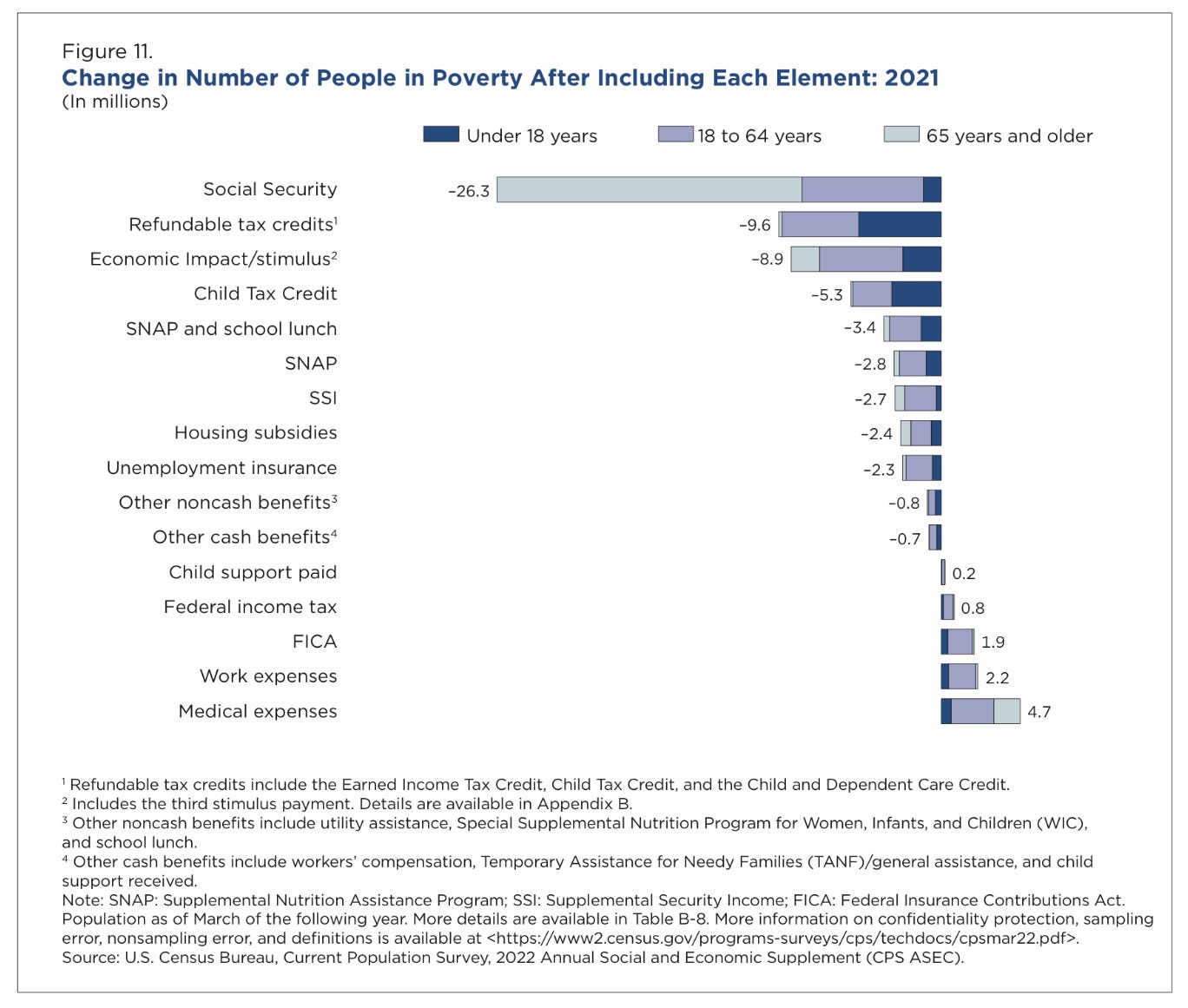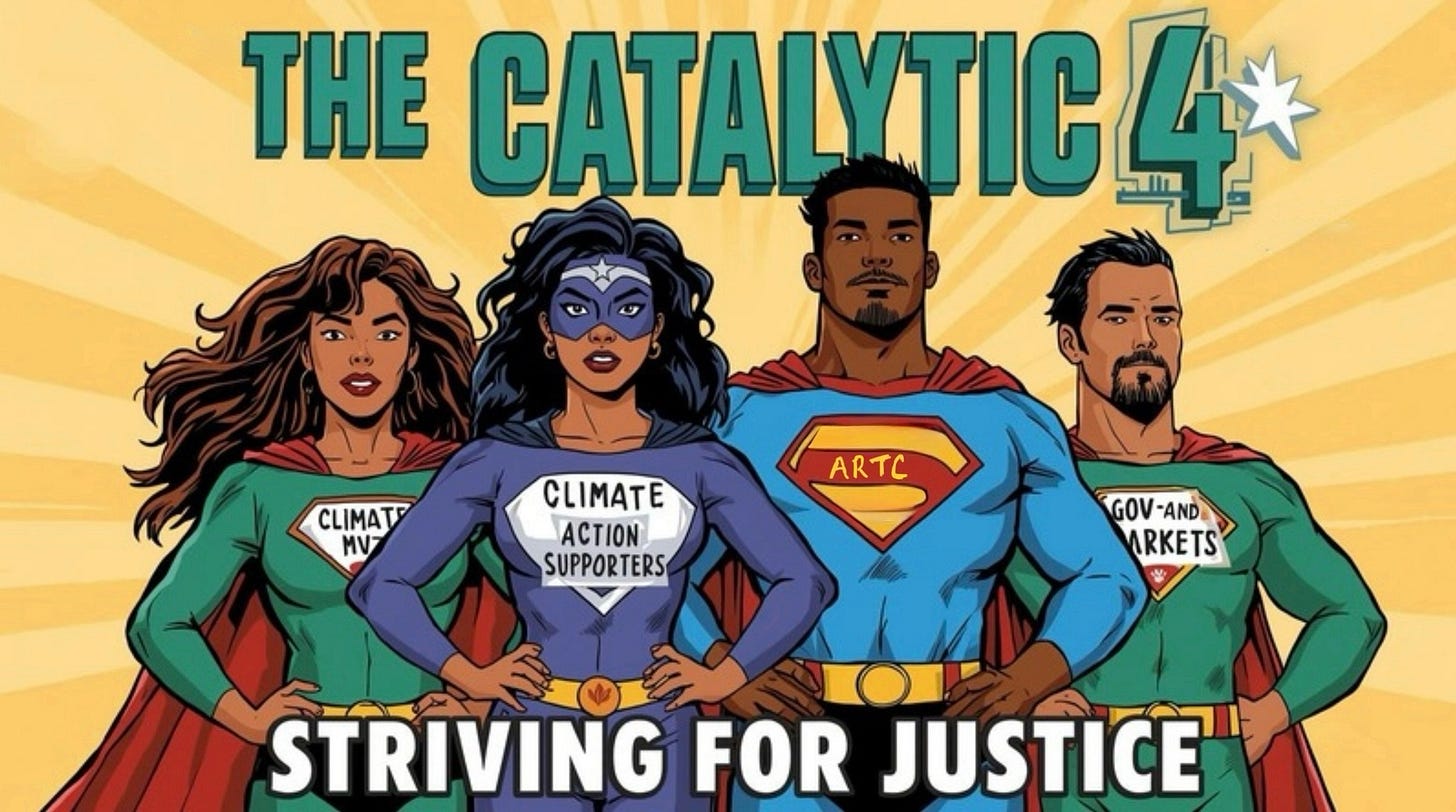Climate Change and the Poor in Rich Countries; Time to Eliminate Poverty
Hope and Justice Series Post #2.4, part of The Who of Justice Subseries
Concerning the poor and climate change and justice, thus far we have talked about what we mean by rich and poor countries and the poor in poorest and emerging countries.
Our final group to discuss are the poor in rich countries. As is the case everywhere, they are the most vulnerable members of their societies.
Rich countries have their own definitions of who is in poverty. In the United States the official estimate is determined by the US Census Bureau.
According to the official poverty rate:
36.8 million people in the US, or 11.1% of the total population, were in poverty in 2021.1
The two graphs in the Census Bureau’s Figure 1 below chart those in poverty and the poverty rate beginning the year the official rate was first calculated in 1959. As can be seen, the 2023 rate of 11.1% is low historically.
The official estimate includes payments and benefits from certain government programs but not others.2
To address this, since 2009 the Census Bureau has provided a second measure of who is poor that it considers to be a supplement to its official rate, incorporating major noncash benefits. This “Supplemental Policy Measure” (SPM) also adjusts for differences in expenses due to geographical location and subtracts expenses related to taxes, work-related expenses, and childcare expenses.
As the Census Bureau’s Figure 6 below shows, the newer SPM poverty rate was higher than the older, official rate up until 2019, when it takes a sharp turn downward and drops to 7.8% in 2021 — the lowest poverty rate ever recorded. It then bounces back to be higher at 12.9% in 2023. In contrast, as Figure 1 shows, the official poverty rate has never dipped below 10%.
Why the sudden drop beginning in 2019 and continuing through 2021, and then bouncing back?
One word: policy.
Pandemic-related benefits in 2021 are the major reason.
As can be seen in Fig. 11, expansions of refundable tax credits — namely the Child Tax Credit, the Earned Income Tax Credit, and the Child and Dependent Care Credit — kept 9.6 million people out of poverty. More than half of that, or 5.3 million, was due to the expanded Child Tax Credit, which went from $2,000 to $3,600 for children under 6 years old, and from $2,000 to $3,000 for older children; in addition, the age limit was raised from 16 to 17. The Credit was made fully refundable, allowing access to families with little or no taxable income, and made available in advance on a monthly basis. These changes kept 2.9 million children out of poverty. The stimulus payments kept 8.9 million from poverty. Combined they reduced the SPM poverty rate for children by 4.5%, driving it to its lowest point ever at 5.2%.
In other words, these findings prove that targeted policies can make a big difference, especially in the lives of children.
With the right policies rich countries can eliminate poverty altogether.
As such, overcoming climate change by creating a just and prosperous sustainability that enhances the wellbeing of everyone, combined with targeted policies to help lift folks out of poverty, especially children, can put the US on a path to eliminate poverty altogether.
It is within our grasp, but we must choose this path.
We must choose this path.
Unfortunately, the pandemic-related expanded Child Tax Credit expired in 2021 and was not renewed in 2022.
The poor in the US are not only vulnerable to climate change pushing them back or deeper into poverty. They are at the mercy of the whims of politicians. As 2021 shows, the right policies are the difference between a poverty rate of 7.8% or 11.6%.
Until such political precariousness ends, we must consider the poor in the US to be the official rate, or 36.8 million people. It is these folks who are the most vulnerable, especially poor children and persons of color. As I said in an earlier post, “no matter where or when you live, if you are poor you are more vulnerable to climate consequences even though you have done little or nothing to cause them.”
Let’s Overcome Climate Change & Eliminate Poverty Together
We in the Climate Movement in the US and other rich nations can and must rise to this challenge of eliminating poverty in our countries (and other countries, too!). Remembering that there is no trickle-down justice, we must intentionally and actively lead the Catalytic-4 into working for justice by lifting people out of poverty, and thus begin to stop bad stuff, in this case economic inequality.
However, we are not just about stopping the bad stuff like poverty. We are also about the other two actions of justice: setting wrong right and making things better.
For the poor are due what everyone is due. And what is that? It’s right there in our Vision, Purpose and Major Goal: to overcome climate change by creating a just and prosperous sustainability that enhances wellbeing for everyone and everything.
And what is “prosperous sustainability”? As I said in my earlier post on the subject,
Prosperous means people having plenty of healthy and delicious food they enjoy, a clean and healthy environment, nice homes that are warm in the winter and cool in the summer, reliable clean energy to power our sustainable lifestyle, work that is meaningful, and time to be creative and enjoy the good things in life. Prosperous means we are all flourishing.
This is what our hearts hope for. As Climate Action Artist-Athletes and Climate Action Supporters and ARTC creators and pro-action policymakers and business people, we can make this hope happen, our future come faster, and the world more beautiful. That’s because justice, hope, and beauty are a triune symbiosis. Whenever we create justice, hope and beauty spring forth like an inexorable law of the Universe. Join us!
If you are new here, check out our Intro Series and other posts in this Hope and Justice Series. If you like this post, please “like,” comment, and share. And thanks for all you’re doing.
US Census Bureau, Poverty In the United States: 2023, Sept. 2024, p. 1. The latest version, Poverty In The United States: 2024, Sept. 2025, is now out. However, because of the Trump Administration’s interference and intimidation related to government reports, I no longer trust that anything put out during the Trump years is accurate. For what it’s worth, here are the numbers from this latest report I can’t trust: “In 2024, the official poverty rate fell 0.4 percentage points to 10.6 percent. There were 35.9 million people in poverty in 2024.”
The Census Bureau’s official poverty rate includes: unemployment compensation, workers compensation, Socical Security, Supplemental Security, Veterans payments, survivor benefits, and disability benefits. But it doesn’t include these noncash benefits: Supplemental Nutritional Assistance Program (SNAP), aka “food stamps”; school lunches; the Supplemental Nutritional Program for Women, Infants, and Children (WIC); energy assistance; Internet assistance, and; housing assistance. These are included in the Supplemental Policy Measure’s poverty rate. See US Census Bureau, Poverty in the United States (2022), pp. 51-53.


